Teamwork thrives on effective communication. Whether in the office, remote, or hybrid, collaborative communication helps teams share ideas, solve problems, and achieve goals together.
This guide will teach you practical strategies, real-world examples, and tools to improve how you work with others. Perfect for team leaders, project managers, or anyone looking to collaborate better—let’s get started!
What Is Collaborative Communication
Collaborative communication is how people share ideas, solve problems, and work together to reach common goals. It’s not just about talking; it’s about listening, understanding, and making sure everyone’s input matters.
At its core, collaborative communication builds trust and strengthens teamwork. It encourages open discussions, respects different viewpoints, and creates a space where everyone feels heard. Whether it’s brainstorming a project, resolving a conflict, or planning next steps, it’s about working together effectively.
When teams communicate collaboratively, they don’t just get things done—they do it in a way that strengthens relationships and drives success.
Core Principles of Collaborative Communication
To communicate better as a team, certain principles help lay the foundation for success. Here are the core principles of collaborative communication:
- Build trust through honesty: Trust is the backbone of teamwork. Being open, transparent, and truthful makes it easier for everyone to work together.
- Respect everyone’s perspective: Great ideas can come from anyone. Listening to and valuing different viewpoints ensures everyone feels included and appreciated.
- Stay focused on solutions: Collaboration thrives when conversations aim to solve problems, not assign blame. Keeping a solution-oriented mindset helps teams move forward.
- Encourage equal participation: Everyone’s input matters. Making space for quieter voices and balancing conversations helps create a stronger, more united team.
- Practice empathy: Understanding others’ feelings and perspectives builds stronger connections. Empathy helps teams communicate with kindness and work through challenges together.
Templates to Streamline Collaborative Communication
Using pre-made templates can make communication within teams more organized and efficient. They provide a visual structure that simplifies complex ideas and ensures everyone is on the same page. Here are some templates that can help streamline collaborative communication:
Team communication plan template
This communication plan template organizes how your team will communicate, including preferred channels and timing. It ensures that everyone knows the best way to reach each other, making communication more efficient and reducing misunderstandings.
Meeting agenda template
A well-organized meeting agenda helps team members stay on track during discussions. It includes the meeting’s purpose, topics to cover, who will speak about each topic, and time limits. This keeps meetings focused and ensures that everyone gets a chance to contribute.
Feedback form template
A feedback form is a structured way to collect thoughts and opinions from team members. It can be used after meetings or project completions to gather feedback on what went well and what could be improved. Using this template helps encourage open communication and continuous improvement.
Project work breakdown structure (WBS)
A work breakdown structure outlines all tasks, deadlines, and milestones for a project. It helps everyone visualize their roles and track progress. This kind of diagram makes it clear what needs to be done, by whom, and when, reducing confusion about project timelines and responsibilities.
SWOT analysis diagram
A SWOT (Strengths, Weaknesses, Opportunities, Threats) diagram helps teams analyze situations and make decisions collaboratively. It provides a visual way to identify areas for improvement, potential risks, and opportunities for growth. Teams can do a SWOT Analysis Online to have productive discussions and create strategic plans.
Decision matrix
A decision matrix helps teams evaluate different options and make group decisions. It lists possible options, the criteria for choosing, and how each option measures up against the criteria. This diagram ensures that decisions are made logically and collaboratively.
RACI matrix
A RACI matrix defines roles and responsibilities in a project. It stands for Responsible, Accountable, Consulted, and Informed. This matrix helps clarify who is doing what, who needs to be kept informed, and who should be consulted for input, making sure there’s no overlap or confusion in tasks.
Brainstorming mind map
A mind map is a visual way to brainstorm ideas. It starts with a central concept and branches out into related ideas, making it easy for teams to organize their thoughts and generate creative solutions together. This diagram encourages collaboration and keeps everyone involved in the brainstorming process.
Practical Strategies for Collaborative Communication in Teams
Effective collaboration requires not just the right tools but also the right approach. Here are some practical strategies to improve communication and teamwork in your group:
1. Set clear expectations
Right from the start, make sure everyone knows what’s expected of them. This includes roles, deadlines, and communication preferences. When everyone is clear about their responsibilities, it reduces confusion and keeps things running smoothly.
2. Encourage open communication
Create an environment where team members feel comfortable sharing their ideas, concerns, and feedback. Encourage people to speak up, ask questions, and be honest. Open communication helps solve problems early and ensures that everyone’s input is valued.
3. Keep meetings focused
Meetings are important but can easily become unproductive. To make them effective, have a clear agenda, keep discussions on track, and respect everyone’s time by sticking to the scheduled duration. If possible, follow up with meeting notes or action items.
4. Use collaborative tools consistently
Choose the right tools for communication (like messaging apps, project management software, or video calls) and use them consistently. Make sure everyone knows how to use these tools and check that they’re being used effectively. This helps avoid confusion and ensures everyone is on the same page.
5. Be respectful of time
Time zones and busy schedules can make communication challenging. Be mindful of when you’re reaching out to team members, especially if they are in different time zones. Consider using asynchronous communication (like emails or shared documents) when real-time communication isn’t necessary.
6. Clarify and confirm information
To avoid misunderstandings, take the time to confirm key points in conversations. If something isn’t clear, don’t hesitate to ask for clarification. It’s better to ask than assume, and confirming ensures everyone is aligned.
7. Foster team bonding
Building strong relationships within a team makes communication easier. Take time to get to know each other, whether through casual chats, team-building activities, or celebrating successes together. When team members feel connected, they are more likely to communicate openly and collaborate effectively.
8. Provide constructive feedback
Giving feedback is essential for growth, but it’s important to do it in a helpful and positive way. Focus on how to improve rather than just pointing out problems. Be specific, offer solutions, and make sure your feedback is actionable.
9. Be flexible and adaptable
Every team and situation is different, so be willing to adjust your communication style to fit the needs of the group. If something isn’t working—whether it’s a tool or a method of communication—be open to trying something new to improve collaboration.
10. Celebrate successes together
Acknowledge the team’s achievements, both big and small. Celebrating wins helps build morale and encourages a positive, collaborative environment. It also reinforces the idea that everyone’s contribution is important to the success of the team.
Examples of Collaborative Communication
Collaborative communication happens in many everyday situations where teamwork is involved. Here are some examples to help you see how it works in real life:
1. Team meetings
During a team meeting, everyone shares updates, ideas, or feedback on a project. For example, brainstorming a marketing campaign where team members suggest ideas, discuss options, and agree on the best approach is collaborative communication in action.
2. Group emails or chats
A team uses a shared chat platform like Slack or group emails to keep everyone updated. For instance, a project manager might send a message asking for input on a new feature, and team members reply with their suggestions.
3. Collaborative document editing
Team members work together on a shared document using tools like Google Docs or Creately. For example, a team drafts a report where one person writes, another edits, and others add comments or suggestions in real time.
4. Project planning sessions
Teams use tools like an online whiteboard tool to map out tasks, set deadlines, and assign responsibilities. For instance, planning an event where the team collaborates to create a timeline and allocate roles ensures everyone is on the same page.
5. Conflict resolution
When a disagreement arises, team members discuss their perspectives openly and respectfully to find a solution. For example, two designers with different ideas for a logo work together to combine elements of both designs into one cohesive concept.
6. Feedback sessions
A manager and team members share feedback during a review meeting. For example, a leader might ask, “What’s working well in our current process?” and encourage the team to suggest improvements.
7. Cross-functional collaboration
Teams from different departments come together to work on a project. For instance, a sales team and a product team collaborate to design a customer-focused feature, combining insights from both areas to create the best outcome.
Why Is Collaborative Communication Important
Collaborative communication is crucial because it helps teams work together more efficiently, solve problems faster, and achieve better results. Here are some reasons why it’s so important:
1. Improves teamwork
Good communication helps team members understand each other, share ideas, and work toward a common goal. When everyone is on the same page, the team functions more smoothly and accomplishes tasks more effectively.
2. Enhances problem-solving
When a team communicates well, they can quickly identify issues and brainstorm solutions. The diverse perspectives of different team members help create more creative and effective solutions.
3. Increases productivity
Clear communication reduces misunderstandings and mistakes, saving time and effort. With everyone knowing their roles and responsibilities, tasks get done faster, and there’s less back-and-forth.
4. Builds trust and relationships
Effective communication fosters trust within a team. When people feel heard and understood, they are more likely to trust each other, which strengthens team bonds and makes collaboration easier.
5. Promotes innovation
Collaborative communication encourages the free exchange of ideas. When team members feel comfortable sharing their thoughts, it leads to more innovation, creativity, and fresh ideas that might not come up in individual work.
6. Supports accountability
When communication is clear and open, it’s easier to track progress and hold each other accountable. Team members are more likely to stay on track with their tasks and meet deadlines when everyone is informed and engaged.
7. Adapts to change
In a fast-paced work environment, things can change quickly. Collaborative communication ensures that everyone is aware of changes, new directions, or unexpected challenges, allowing teams to adapt and stay on course.
8. Boosts morale
Regular communication keeps team members connected and motivated. When everyone communicates openly and works together, it builds a positive work environment, which leads to higher job satisfaction and morale.
Collaborative Communication Skills
To communicate well with others in a team, certain skills are essential. These skills help create clear, productive conversations and strong teamwork. Here’s a breakdown of the key collaborative communication skills:
1. Active listening
Active listening means truly focusing on what the other person is saying, without interrupting or thinking about your response while they talk. It shows you value their input and helps you understand their point of view better.
2. Clarity and conciseness
When sharing your ideas, it’s important to be clear and to the point. Avoid using jargon or long explanations. Simple, direct language helps others understand your message quickly and reduces confusion.
3. Empathy
Empathy means understanding and sharing the feelings of others. In a team, it’s important to consider how others might feel about a situation or idea. Empathy helps strengthen relationships and encourages open, honest communication.
4. Constructive feedback
Giving feedback in a way that’s helpful and encouraging is key to good collaboration. Instead of criticizing, focus on offering solutions or suggestions for improvement. Constructive feedback helps everyone grow and move forward together.
5. Asking questions
Asking the right questions encourages deeper conversations and shows that you’re interested in others’ opinions. Questions help clarify points, resolve confusion, and ensure everyone is on the same page.
6. Non-verbal communication
Body language, facial expressions, and tone of voice all play a big role in communication. For example, maintaining eye contact shows you’re engaged, while a smile can make conversations feel more positive and welcoming.
7. Adaptability
Every team member has their own communication style. Being adaptable means adjusting the way you communicate based on the person or situation. Whether it’s choosing the right method (email, call, chat) or adjusting your tone, adaptability makes communication smoother.
How to Develop Collaborative Communication Skills
Improving how you communicate with others can make teamwork more productive and enjoyable. Here’s a closer look at essential skills to develop:
1. Listen actively
Active listening means giving your full attention to the person speaking. It’s not just about hearing words; it’s about understanding the message. Show you’re listening by nodding, maintaining eye contact, or saying things like, “That makes sense” or “Can you explain that part again?” Avoid interrupting or thinking about your response while they’re still talking. This helps build trust and shows you value their input.
2. Ask clear questions
Asking good questions can lead to better conversations and stronger collaboration. Open-ended questions like, “What are your thoughts on this approach?” encourage people to share more. Avoid vague or overly complicated questions that might confuse others. If something isn’t clear, don’t hesitate to ask for clarification—it shows you care about understanding them fully.
3. Give constructive feedback
Feedback is a part of teamwork, but how you give it makes a difference. Focus on what can be improved and offer solutions instead of just pointing out problems. For example, instead of saying, “This doesn’t work,” try, “This could work better if we tweak it this way.” Always be respectful and specific so the other person knows exactly what to work on and doesn’t feel criticized.
4. Be mindful of your tone
The way you say something matters as much as the words you use. A calm, respectful tone can prevent miscommunication and reduce tension. For example, instead of saying, “You need to finish this now,” try, “Can we prioritize this task together?” Your tone sets the mood of the conversation and can influence how others respond.
5. Use positive body language
Your body language speaks volumes, even if you don’t say a word. Simple actions like nodding, smiling, or leaning slightly forward can show you’re engaged and interested. Avoid crossing your arms or looking away, as this can make you seem uninterested or closed off. Positive body language helps others feel comfortable sharing their ideas with you.
6. Adapt to different communication styles
Not everyone communicates in the same way. Some people prefer quick, straight-to-the-point updates, while others like detailed discussions. Pay attention to how your teammates communicate and try to adapt. For example, if someone prefers email updates, use that instead of calling them. Understanding and respecting these differences make it easier to collaborate effectively.
Collaborative Communication Tools
Using the right tools can make teamwork much easier and more efficient. Here are some popular collaborative communication tools that help teams stay connected and work together smoothly:
1. Email
Email is a basic but essential tool for communicating with team members. It’s great for sharing updates, providing detailed information, and following up on tasks. However, it works best for less urgent communication.
2. Instant messaging and chat platforms
Tools like Slack, Microsoft Teams, or Google Chat allow team members to send quick messages, ask questions, and share ideas in real time. These platforms keep conversations organized by creating channels for specific topics or projects.
3. Video conferencing
Video calls on platforms like Zoom, Google Meet, or Microsoft Teams help teams connect face-to-face, even if they’re working from different locations. Video conferencing is ideal for meetings, brainstorming sessions, or discussions that require more personal interaction.
4. Project management tools
Tools like Trello and Asana allow teams to organize tasks, set deadlines, and track progress. These platforms help everyone stay on top of their responsibilities and make sure no tasks are forgotten.
5. Collaborative document editing
Google Docs, Microsoft OneDrive, and tools like Creately let multiple team members work on a document at the same time. You can edit, comment, and suggest changes in real-time, making it easy to collaborate on reports, presentations, and other shared projects.
6. Shared calendars
Tools like Google Calendar or Outlook Calendar let teams schedule meetings, set reminders, and view everyone’s availability. Shared calendars help avoid scheduling conflicts and ensure everyone is on the same page for upcoming events or deadlines.
7. File sharing platforms
Google Drive, Dropbox, or OneDrive allow teams to store, share, and access important files from anywhere. These tools make it easier to collaborate on documents, presentations, or spreadsheets by allowing everyone to access the latest versions.
8. Whiteboard tools
Online whiteboard tools like Creately allow teams to brainstorm, create diagrams, or plan projects visually. These tools help organize ideas, work through problems, and collaborate in a more creative, interactive way.
Addressing Barriers in Collaborative Communication
Sometimes, communication can break down due to certain barriers. These barriers can make it hard for teams to work together smoothly. Here are some common obstacles and how to overcome them:
1. Miscommunication
- Barrier: Sometimes, messages aren’t clear or are misunderstood. This can lead to confusion and mistakes.
- Solution: Be clear and concise in your communication. If something is important, make sure to confirm that everyone understands. Ask for feedback or clarification when needed.
2. Lack of trust
- Barrier: If team members don’t trust each other, they may hesitate to share ideas or be open. This can slow down progress and reduce collaboration.
- Solution: Build trust by encouraging open communication, being respectful, and keeping promises. Creating a supportive environment where everyone feels safe to share helps build trust over time.
3. Different communication styles
- Barrier: Every person has their own way of communicating. For example, some may be direct, while others prefer a more diplomatic approach. These differences can lead to misunderstandings.
- Solution: Be aware of different communication styles. Adapt your approach depending on the person or situation. Encourage team members to express their preferences for how they like to communicate.
4. Lack of time
- Barrier: Busy schedules can make it hard to find time for important discussions. When team members aren’t available to communicate, it can cause delays or problems.
- Solution: Use tools that allow for flexible communication, like email or instant messaging, for less urgent matters. Set aside specific times for meetings or check-ins to ensure everyone is on the same page.
5. Language and jargon
- Barrier: Using complicated language or technical terms can confuse team members, especially if they’re not familiar with them.
- Solution: Avoid using jargon or overly technical terms unless necessary. If you must use them, explain them clearly. Keep the language simple and accessible for everyone on the team.
6. Cultural differences
- Barrier: In diverse teams, cultural differences can affect communication. For example, some cultures may prioritize indirect communication, while others prefer directness.
- Solution: Be respectful of cultural differences and open to learning about them. Encourage inclusive communication that values everyone’s perspective, and avoid making assumptions based on cultural norms.
7. Emotional barriers
- Barrier: Personal emotions, like stress or frustration, can affect communication. When emotions run high, it may be difficult to listen or respond calmly.
- Solution: Be mindful of your emotions and those of others. Practice active listening and remain calm when discussing difficult topics. Take a break if needed to cool down before continuing the conversation.
8. Technological issues
- Barrier: In remote teams, technical problems like slow internet or malfunctioning tools can disrupt communication.
- Solution: Make sure all team members have access to reliable tools and know how to use them. Have backup plans in place for technical issues, like phone calls or messaging apps, if needed.
Foster Collaborative Communication with Creately
Creately is a powerful visual collaboration tool that can help teams collaborate more effectively by improving communication and streamlining workflows. Here’s how you can use Creately to foster better collaboration:
1. Visual collaboration
Creately allows teams to create diagrams, flowcharts, and mind maps that make complex ideas easier to understand. By visualizing concepts, teams can communicate more clearly, ensuring everyone is on the same page.
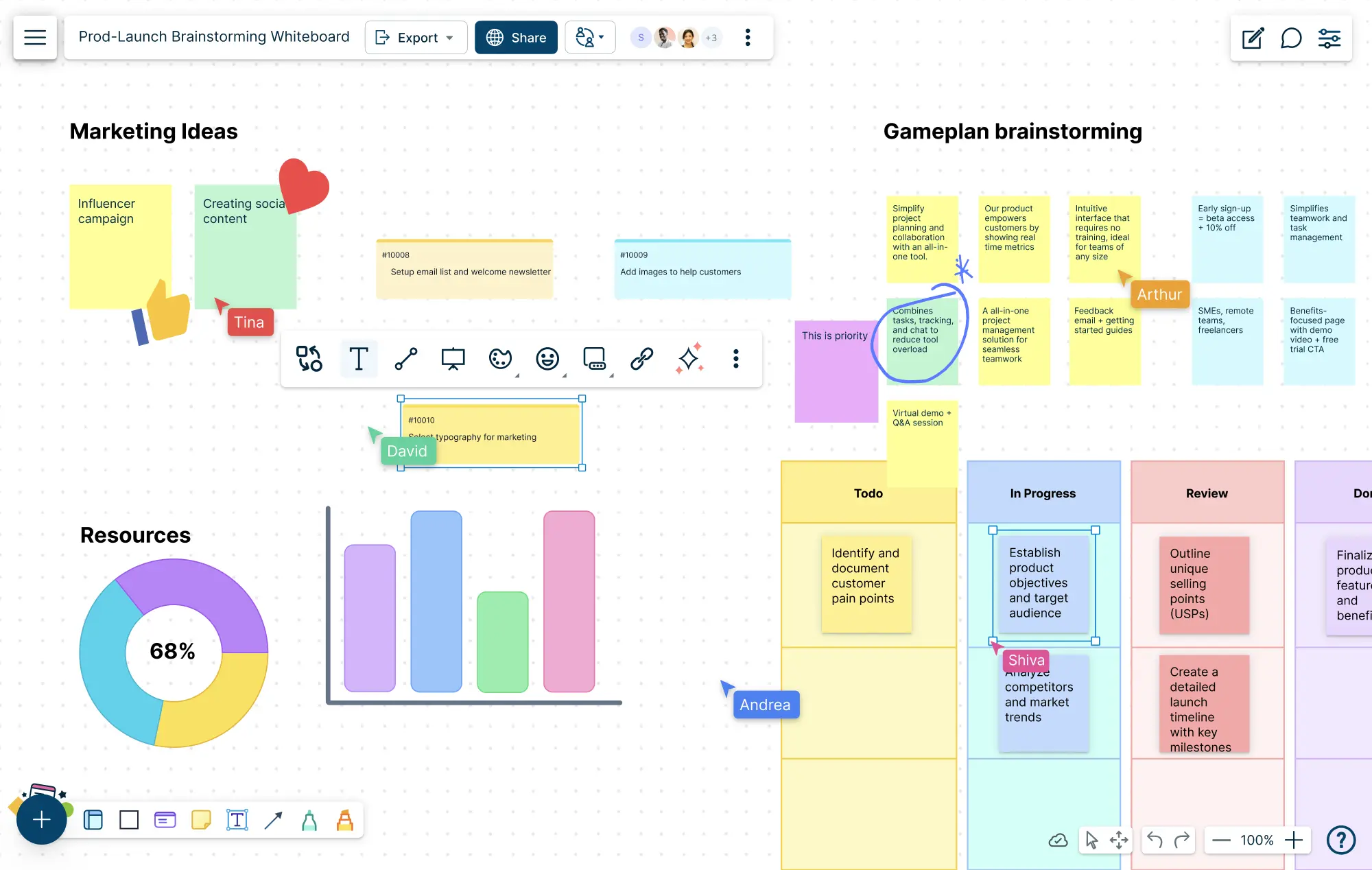
2. Real-time collaboration
With Creately, multiple team members can work on the same document at the same time. This real-time collaboration helps reduce delays and ensures that everyone can contribute, providing immediate feedback and making updates on the spot.
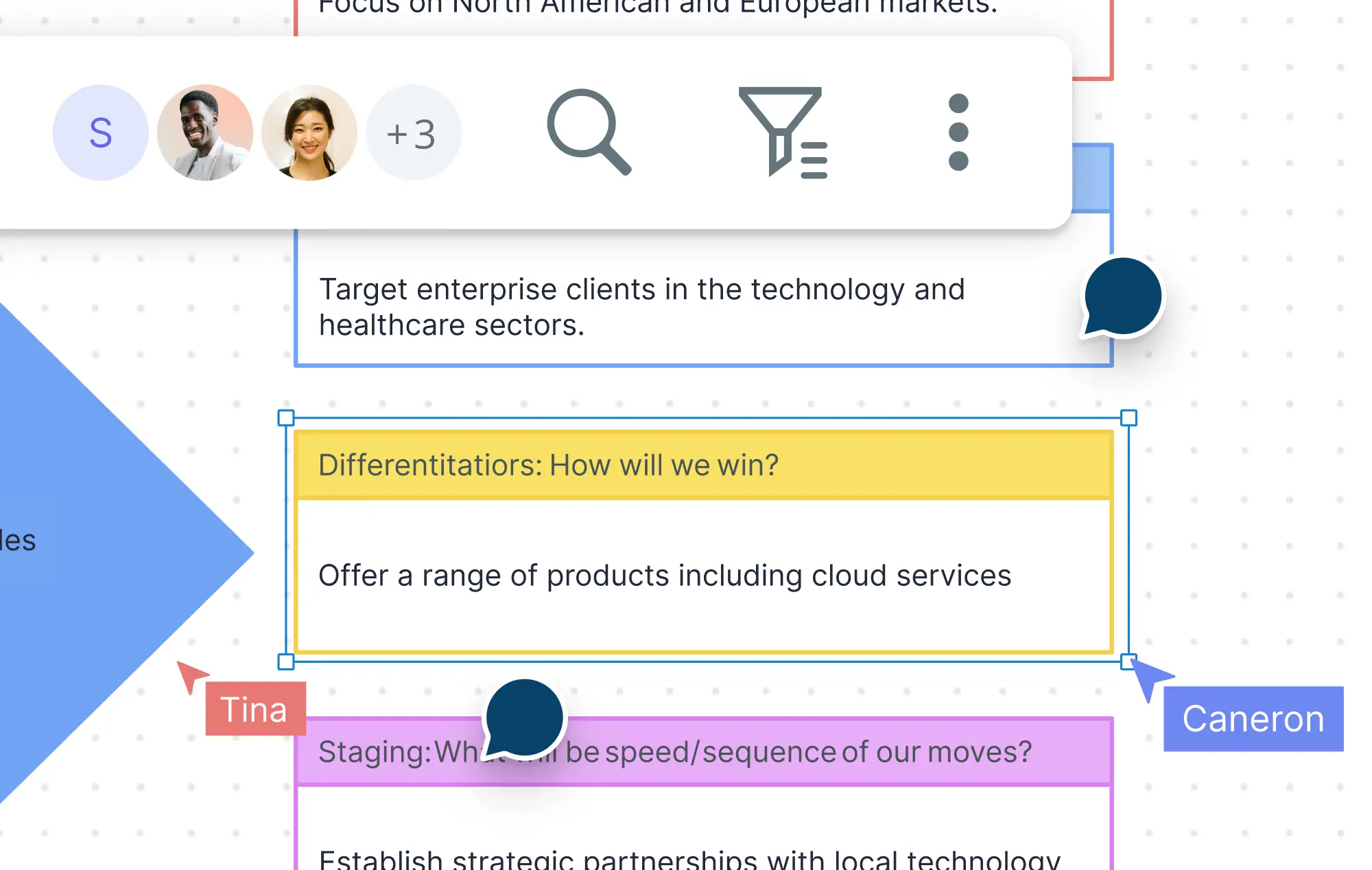
3. Easy sharing
Creately makes sharing work with team members simple. You can easily send links or embed your diagrams in emails or presentations, making it easy to keep everyone in the loop. This feature helps reduce the risk of miscommunication by ensuring information is always accessible.
4. Centralized communication
Creately keeps all your collaborative efforts in one place. Whether it’s a project plan, feedback, or action items, everything is stored in the same document. This reduces confusion about where to find important information, making communication more efficient.
5. Feedback and comments
Team members can leave comments directly on the diagrams, making it easier to provide specific feedback. This feature encourages open communication and ensures that everyone’s voice is heard.
6. Integration with other tools
Creately integrates with popular tools like Google Drive, Slack, Microsoft Teams and Confluence. This makes it easy to embed diagrams into your existing workflow, keeping communication smooth across different platforms.
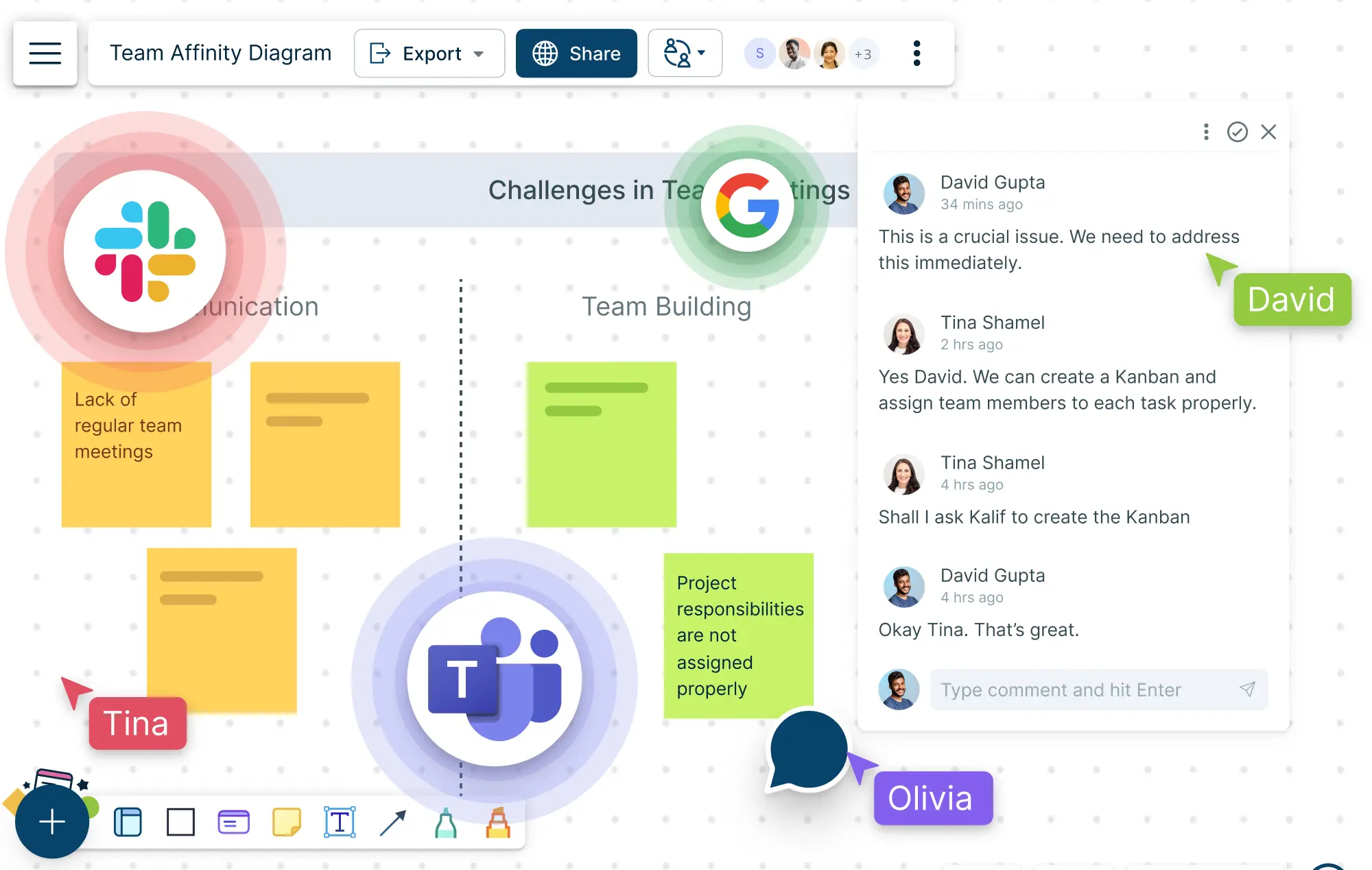
7. Templates for efficiency
Creately offers a wide range of templates for common collaboration scenarios, such as project planning, brainstorming, and process mapping. Using these templates helps teams save time and communicate more effectively by starting with a clear structure.
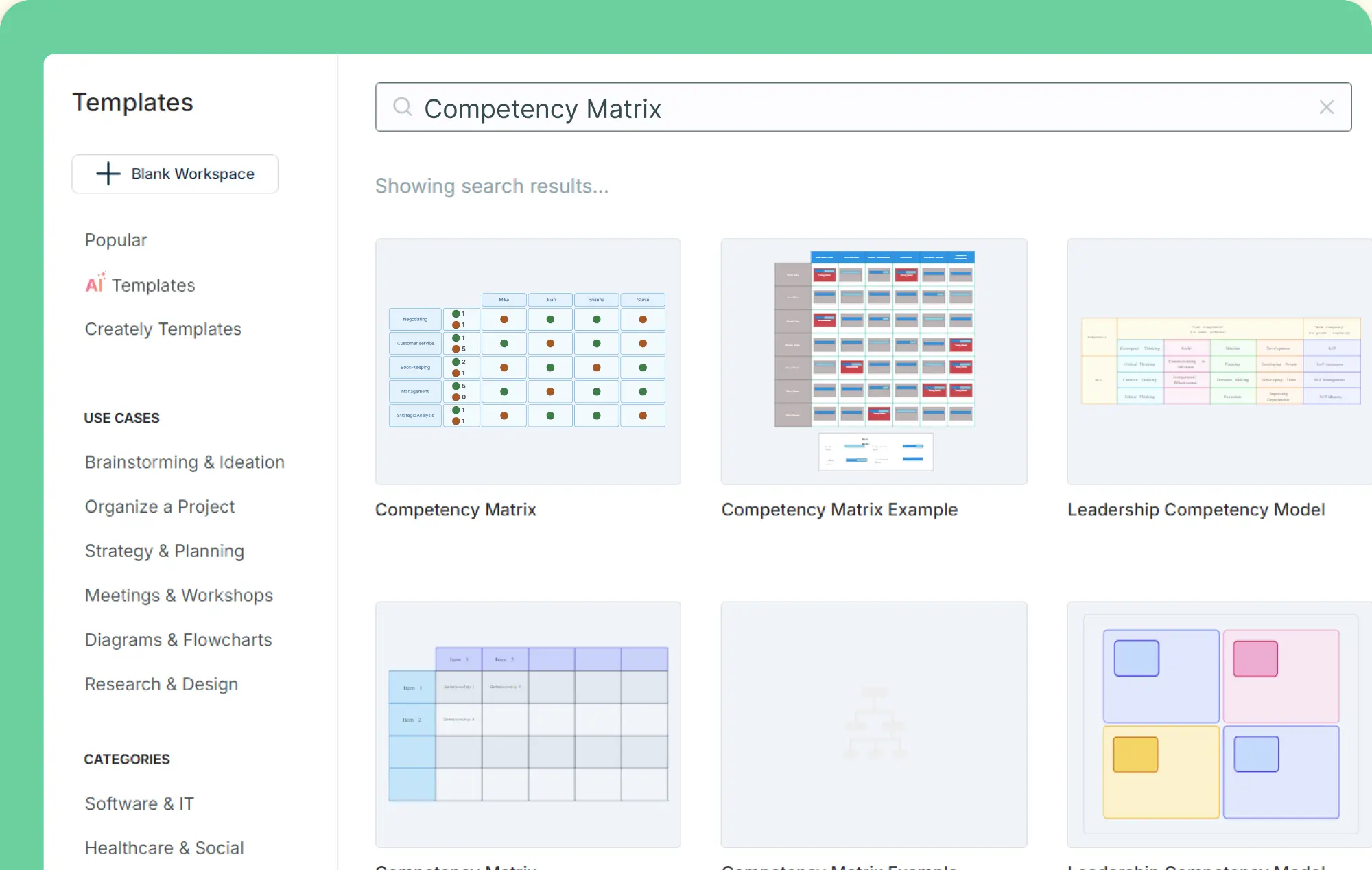
8. Customizable and user-friendly
Creately’s easy-to-use interface allows everyone on the team, regardless of their technical skills, to create diagrams and collaborate effectively. This ensures that all team members can participate in the communication process, regardless of their experience level.
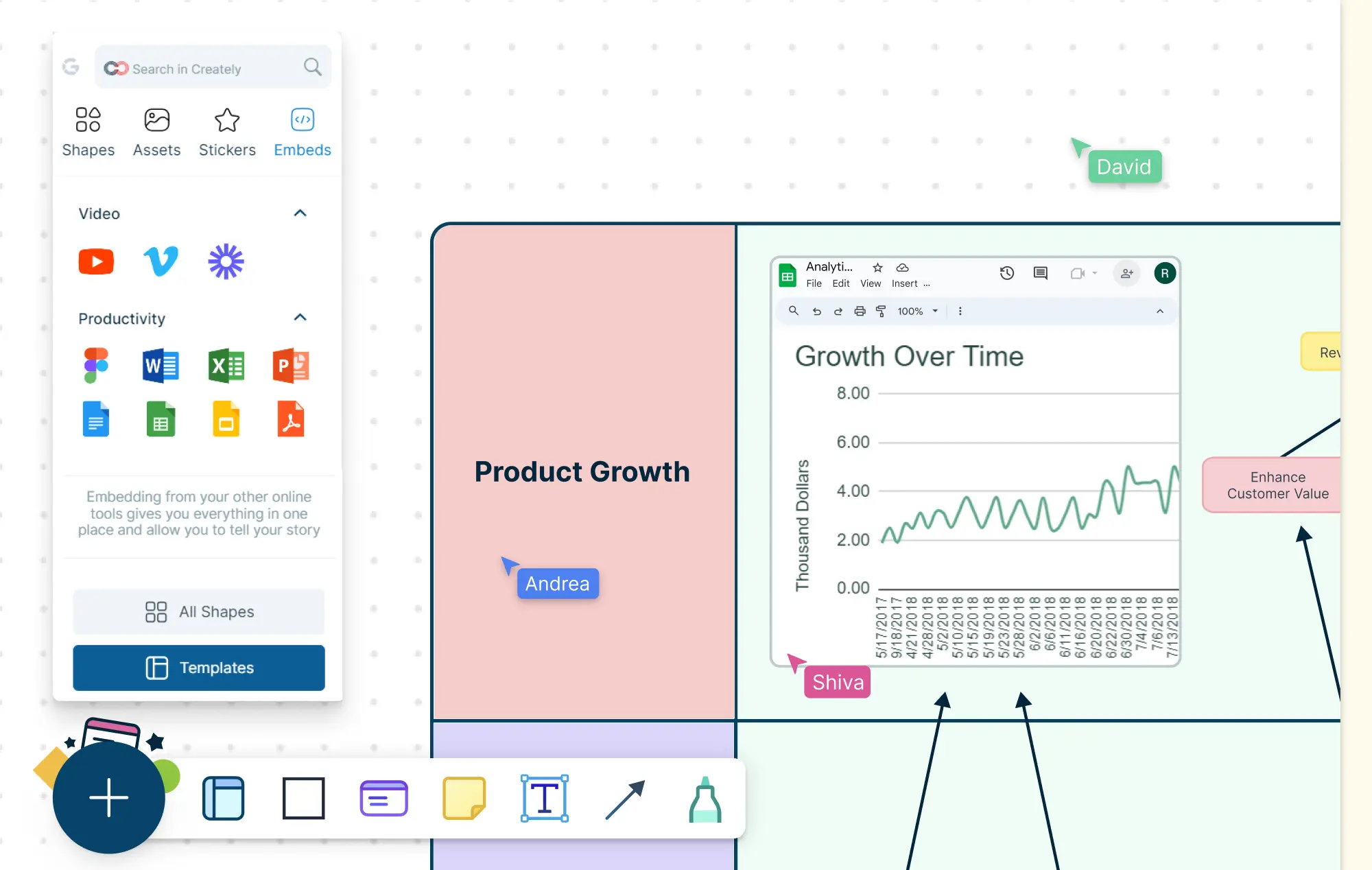
9. Voting
Creately’s voting feature helps teams quickly decide on options or gather feedback. Team members can vote on ideas or solutions, making decision-making more democratic and faster.
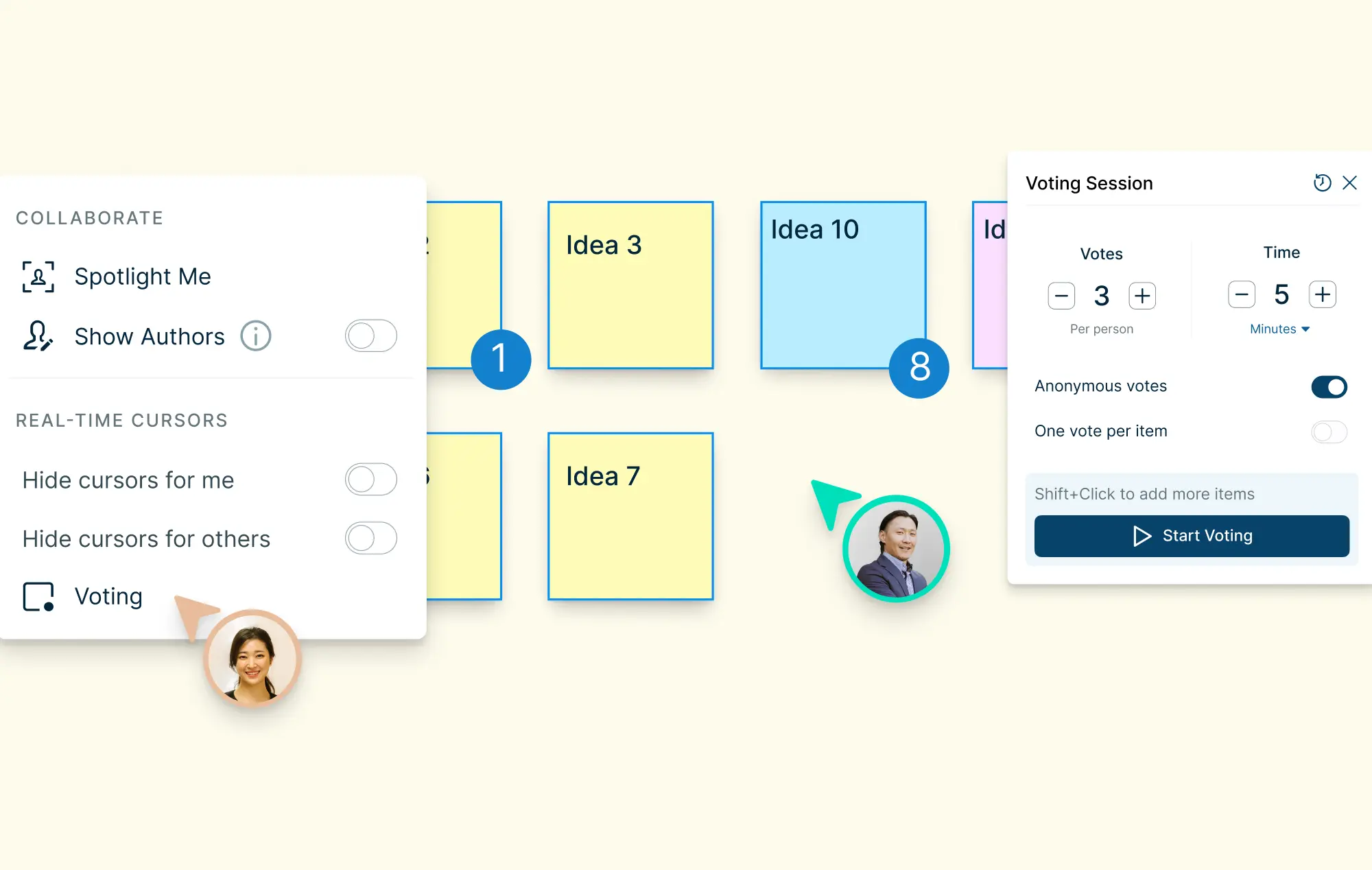
10. Presentation mode
Creately’s presentation mode allows teams to present their ideas or projects visually during meetings. This feature helps communicate complex ideas more clearly and keeps everyone engaged, making it easier to discuss and refine ideas in real-time.

Conclusion: Effective Collaborative Communication for Better Teamwork
Effective collaborative communication is key to a team’s success. By using the right strategies, tools, and practices, teams can work together more smoothly, share ideas openly, and solve problems faster. Whether it’s through clear communication channels, active listening, or overcoming common barriers, fostering collaboration leads to better outcomes and stronger relationships among team members.
Remember, good communication is not just about speaking, but about listening, understanding, and responding in a way that encourages teamwork. By embracing collaborative communication, you can create a more productive, creative, and supportive environment where everyone can thrive.
References
Natia Vacheishvili (2021). Collaborative Communication as an Effective Strategy in Education. [online] ResearchGate. Available at: https://www.researchgate.net/publication/353606348_Collaborative_Communication_as_an_Effective_Strategy_in_Education.
Farid Baskoro, Bambang Suprianto, Lilik Anifah and Yuyun Atik Indriani (2023). The Magic of Communication and Collaboration: Enhancing Sensor and Actuator Competence for Successful Learning. [online] ResearchGate. Available at: https://www.researchgate.net/publication/374269798_The_Magic_of_Communication_and_Collaboration_Enhancing_Sensor_and_Actuator_Competence_for_Successful_Learning.
FAQs about Collaborative Communication
Can collaborative communication help boost creativity in a team?
How to improve communication when team members have different styles?
How to make sure all voices are heard in team communication?
How to balance formal and informal communication?
How to build trust for better collaborative communication?






